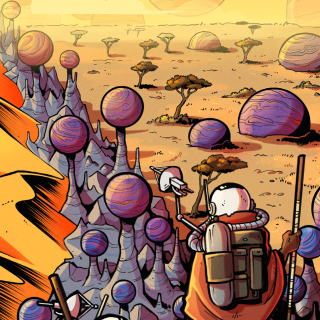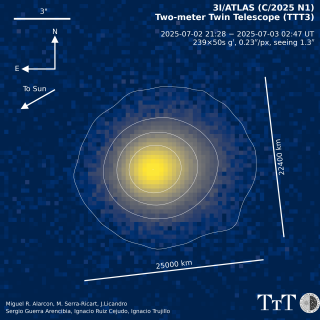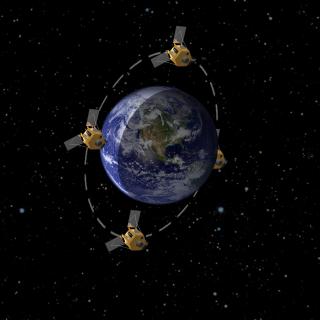Las primeras Jornadas de Puertas Abiertas en el Observatorio del Roque de los Muchachos (La Palma) correspondientes al año 2001, celebradas el pasado domingo, 15 de julio, y organizadas por el Instituto de Astrofísica de Canarias, atrajeron al Observatorio a 2.272 visitantes. Durante la jornada se pudieron visitar seis instalaciones distintas: el telescopio "William Herschel", el telescopio "Isaac Newton", el telescopio Nacional Galileo, el telescopio Nórdico Óptico, el telescopio "Mercator" y el experimento HEGRA. La organización contó con la colaboración de 48 personas, entre astrónomos de las distintas instituciones usuarias del Observatorio, personal propio de apoyo (administrativo, sanitario y de mantenimiento), además de diversas entidades como la agrupación de astrónomos aficionados "Isla de la Palma", AEA, Guardia Civil y Cruz Roja. Las visitas se realizaron en tres idiomas: español, inglés y alemán, y los 2.272 visitantes fueron divididos en 84 grupos distintos, cifras que superan considerablemente las de las jornadas celebradas el pasado año. La novedad en esta ocasión fue la posibilidad de visitar el telescopio "Mercator", el "benjamín" del Observatorio, que entró en funcionamiento el pasado mes de mayo. Se recuerda que las próximas Jornadas de Puertas Abiertas tendrán lugar el domingo 9 de septiembre.
Advertised on
It may interest you
-
 An international scientific team, including members of the Instituto de Astrofísica de Canarias (IAC), has launched an ambitious program to map exoplanets located around the Neptunian Desert —a region around stars where planets the size of Neptune are very rare— in order to better understand the mechanisms of planetary system evolution and formation. This scientific expedition has delivered its first results with the observation of the TOI-421 planetary system. Analysis of this system reveals a surprisingly inclined orbital architecture, offering new insights into the chaotic history ofAdvertised on
An international scientific team, including members of the Instituto de Astrofísica de Canarias (IAC), has launched an ambitious program to map exoplanets located around the Neptunian Desert —a region around stars where planets the size of Neptune are very rare— in order to better understand the mechanisms of planetary system evolution and formation. This scientific expedition has delivered its first results with the observation of the TOI-421 planetary system. Analysis of this system reveals a surprisingly inclined orbital architecture, offering new insights into the chaotic history ofAdvertised on -
 The Instituto de Astrofísica de Canarias (IAC) is actively participating in the observation of object 3I/ATLAS (C/2025 N1 ATLAS), initially included as A11pl3Z in the confirmed list of Near-Earth Objects (NEOs) of the International Astronomical Union's Minor Planet Centre (IAU/MPC). The object, which has been shown to be the third interstellar object detected in our solar system, was discovered by one of the telescopes in the ATLAS network for the detection and early warning of asteroids on an Earth-impact trajectory. The IAC is part of this network with its new telescope structure, ATLASAdvertised on
The Instituto de Astrofísica de Canarias (IAC) is actively participating in the observation of object 3I/ATLAS (C/2025 N1 ATLAS), initially included as A11pl3Z in the confirmed list of Near-Earth Objects (NEOs) of the International Astronomical Union's Minor Planet Centre (IAU/MPC). The object, which has been shown to be the third interstellar object detected in our solar system, was discovered by one of the telescopes in the ATLAS network for the detection and early warning of asteroids on an Earth-impact trajectory. The IAC is part of this network with its new telescope structure, ATLASAdvertised on -
 El Instituto de Astrofísica de Canarias (IAC), a través de su departamento IACTEC-Espacio, celebra hoy la System Requirements Review (SRR) de la misión IACSAT-1, un hito clave que marca la finalización de la fase B1 del proyecto y consolida todos los requisitos técnicos, científicos y programáticos necesarios para avanzar hacia el diseño preliminar del satélite. IACSAT-1 es la primera misión liderada íntegramente por el IAC dedicada a la observación astronómica desde el espacio. Se trata de un proyecto desarrollado por IACTEC-Espacio, con un equipo científico dirigido por el Prof. RafaelAdvertised on
El Instituto de Astrofísica de Canarias (IAC), a través de su departamento IACTEC-Espacio, celebra hoy la System Requirements Review (SRR) de la misión IACSAT-1, un hito clave que marca la finalización de la fase B1 del proyecto y consolida todos los requisitos técnicos, científicos y programáticos necesarios para avanzar hacia el diseño preliminar del satélite. IACSAT-1 es la primera misión liderada íntegramente por el IAC dedicada a la observación astronómica desde el espacio. Se trata de un proyecto desarrollado por IACTEC-Espacio, con un equipo científico dirigido por el Prof. RafaelAdvertised on